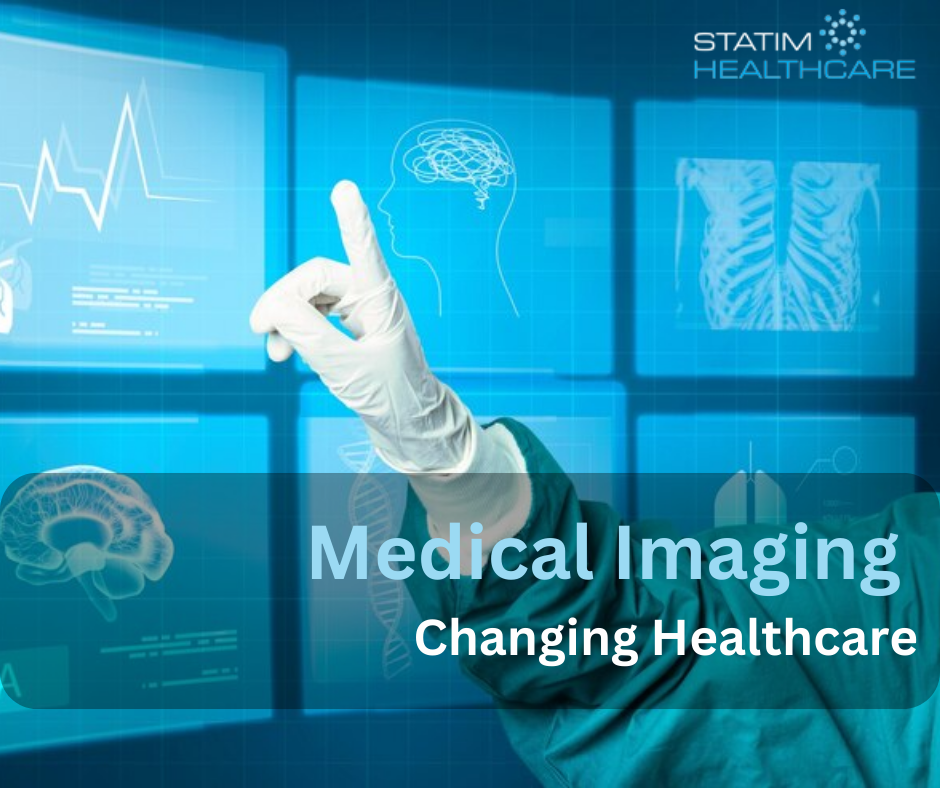Medical Imaging Technique (MIT) developed rapidly to play an essential role in the medical industry for supporting the diagnosis and treatment of diseases. It comprises various technologies like X-ray, Mammography, Ultrasonography, CT Scan (Computer Tomography), and nuclear medicine. In the new era, Medical imaging saves millions of lives each year, enabling doctors to detect and diagnose various diseases, from appendicitis and cancer to stroke and heart disease. Join us as we explore four medical imaging and diagnostics trends changing the healthcare industry for the increasing demand for accurate and timely diagnostic imaging services.
What is Medical Imaging?
Medical imaging refers to the process of obtaining a visual representation or image of the integral parts of the human body. It is mainly used for clinical analysis and medical intervention by healthcare experts for identifying, diagnosing, and treating a variety of medical disorders.
Here are various types of medical imaging technologies and their application:
- X-rays: Used to visualize bones and detect fractures, tumors, and infections.
- Computed Tomography (CT): Provides detailed cross-sectional images of the body, helpful in diagnosing conditions like cancer, cardiovascular diseases, and traumatic injuries.
- Magnetic Resonance Imaging (MRI): Uses powerful magnets and radio waves to produce detailed images of soft tissues, organs, and the nervous system. Useful for detecting tumors, multiple sclerosis, and joint injuries.
- Ultrasound: Utilizes high-frequency sound waves to create images of organs, blood vessels, and unborn babies. Commonly used in obstetrics, cardiology, and evaluating abdominal and pelvic conditions.
- Positron Emission Tomography (PET): Involves injecting a small amount of radioactive material to visualize cellular activity, useful in cancer diagnosis, brain disorders, and cardiac conditions.
- Single-Photon Emission Computed Tomography (SPECT): Similar to PET, but uses different radioactive tracers to assess organ function and blood flow, particularly in the brain and heart.
- Nuclear Medicine: Involves administering radioactive substances to diagnose and treat diseases such as cancer, thyroid disorders, and bone abnormalities.
- Mammography: Specifically for breast imaging, helping detect early signs of breast cancer.
- Fluoroscopy: Real-time X-ray imaging used to guide procedures like catheter placements and swallowing studies.
- Endoscopy: Involves inserting a flexible tube with a camera to visualize the inside of organs like the digestive tract, respiratory system, and bladder.
Key Trends in Medical Imaging
Artificial Intelligence (AI) and Machine Learning (ML)
AI and ML have become increasingly important in medical imaging and diagnostics. These technologies can improve diagnostic accuracy, assist radiologists in detecting anomalies, and streamline workflow.
Enhanced Role of AI in Medical Image Diagnosis
AI is being used to assist radiologists in spotting anomalies in human tissues. This technology can improve diagnostic accuracy and reduce the time required for analysis.
Improving the Patient Experience
Medical imaging and diagnosis technologies contribute to a significant role when it comes to patient experience. It can be used for bedside imaging, allowing healthcare professionals to perform imaging procedures at the patient’s bedside.
Rapidly Changing Technology
Medical imaging technology is rapidly evolving, driven by advancements in artificial intelligence (AI) and the Internet of Things (IoT). From the invention of X-rays in 1895 to the integration of artificial intelligence (AI) methods, significantly increasing CT scan and ultrasound examinations, enabling accurate diagnosis and improved patient outcomes.
The market size of health imaging services in USA was valued at USD 139.6 billion in 2022 and is projected to grow at a compound annual growth rate (CAGR) of 4.18% from 2023 to 2030. Similarly, the diagnostic imaging services market size was valued at USD 122.41 billion in 2022 and is expected to grow to USD 206.84 billion by 2030, indicating a CAGR of 6.8% during the forecast period.
Why Demand for Medical Imaging Solutions is Rising?
- Accurate Diagnosis: Medical imaging allows healthcare professionals to accurately identify various medical disorders.
- Non-Invasive Nature: Many medical imaging methods are non-invasive, reducing patient discomfort, infection risk, and healing time.
- Early Detection of Diseases: Medical imaging enables early diagnosis, leading to prompt treatment and improved survival rates.
- Guidance for Surgical Procedures: Imaging techniques like CT scans, ultrasound, and MRI provide real-time and preoperative insights, improving surgical planning and execution.
- Monitoring Treatment Progress: Medical imaging helps healthcare professionals assess the effectiveness of therapies and track the progress of conditions like broken bones or tumors.
- Research and Development: Medical imaging supports medical research by providing information on disease causes, treatment efficacy, and anatomical differences.
- Personalized Medicine: Medical imaging allows personalized treatment based on a patient’s unique anatomy and condition.
- Patient Education: Patients can better understand their diseases and treatments by viewing their medical images.
- Emergency and Trauma Care: Medical imaging quickly assesses the severity of injuries, enabling immediate action in emergencies.
- Pediatric Care: Medical imaging plays a crucial role in diagnosing diseases in children who may struggle to express their symptoms.
- Quality Assurance and Training: Diagnostic health imaging helps evaluate diagnoses, ensures quality assurance, and aids in teaching new medical practitioners.
Transforming Healthcare with Expert Radiology Reporting
We are a healthcare informatics company providing knowledge-based medical imaging solutions to hospitals and diagnostic centers worldwide. We provide a wide range of services like medical transcription, radiology reporting, billing, coding, and SaaS. Our US-based RIS software solution runs 24×7 with the capability to serve very large volumes. Contact us today and experience unparalleled expertise in reporting cases across multiple specialties.

